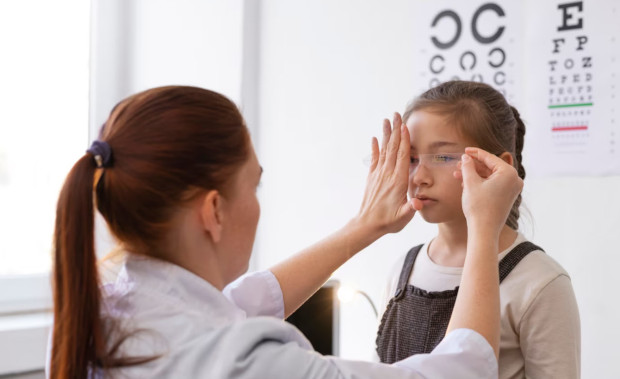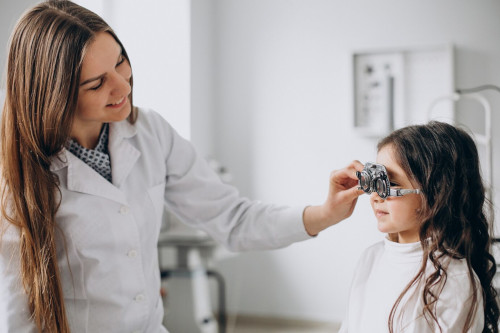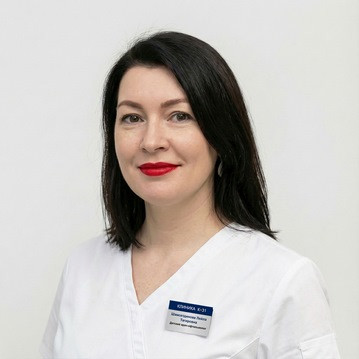Pediatric ophthalmology

specialists

equipment

treatment
When should you see an ophthalmologist?

- If your child complains that he/she has trouble seeing into the distance, has started squinting
- If the child has a tear, the eye is red and/or there is discharge, there are other symptoms and signs of the development of an inflammatory process
- If the child, after a long visual load (reading, writing, playing on gadgets), begins to rub his/her eyes, blink more often, and at the end of the school day has a headache and no desire to do homework
- If you notice that the child has started to “squint”, “run away” the eye, or they “run away” in turn, and also compassionate neighbors or relatives increasingly tell you about this
- If you notice that the child has poor spatial orientation, “collects” all the corners, often misses

General information
It is difficult to list all the possible reasons, symptoms and signs that should be of concern and schedule a visit to the ophthalmologist. Or, on the contrary, our ophthalmologists will help you dispel doubts and confirm that your child has no problems with the organ of vision at the time of examination.
Vision treatment by our ophthalmologists is prescribed according to modern standards, taking into account the individual characteristics of the child, the course of the disease and age:
- Newborns. At this age, it is possible to determine the development of diseases such as inflammation, conjunctivitis, cataracts, and begin treatment. If the child is premature, in this case the risk of retinopathy is high (symptoms appear somewhere after the fourth week of life). It is advisable to visit an ophthalmologist for examination every 2-3 months during the first year of life
- Preschool age. From the age of three, visual acuity, binocular vision, optical power and the presence/absence of farsightedness are determined. Mandatory visits to the ophthalmologist are at one year and then at three years
- School-age children. Such vision pathologies as strabismus, astigmatism, myopia, refractive and accommodation disorders are detected. These pathologies are successfully treated. It is necessary to visit an ophthalmologist before school, and then, due to the increased strain on the eyes during school, you need to visit an ophthalmologist every year
Each age has its own developmental features, and the detection of certain vision pathologies and eye diseases in children is not yet a final and lifelong diagnosis and does not always require treatment (or at least some radical treatment methods). The eye grows, the visual apparatus changes, and the specialist must be aware of normal developmental deviations in each period of the child's maturation. But you need to undergo examinations regularly in order to detect diseases and other important deviations of vision from the norm in time. This will allow you to take timely measures and begin treatment before the pathology or defect worsens.
In the ophthalmology department of our clinic, your child will be examined by an ophthalmologist of the highest category, familiar with all the features of children's vision, the development and structure of the eye and its adnexa. Parents can be confident in the accuracy of the diagnosis and the effectiveness of the prescribed treatment. We conduct examinations and apply treatment methods that are suitable for the fragile body of a child.
What diseases of the organ of vision do we treat?
Correction with glasses (including the appointment of special spectacle lenses to prevent the progression of myopia). If necessary, the appointment of contact lenses.

Correction with "night" lenses (ortholenses) - when, with regular wear at night, a child does not need glasses or lenses during the day and sees perfectly. At the same time, parents can be calm that myopia (myopia) is under control! We use Moonlens ortholenses, the only "night lenses" certified by the FDA (Food and Drug Administration, USA).

We provide hardware treatment of myopia and accommodation disorders on the devices "Visotronic M-3", "MAKDEL-09" and pneumomassage ("AVMO-01"). This type of treatment is extremely important to improve the work of a special muscle of the eye - accommodative (ciliary) to reduce the further progression of myopia. For example, the simulator "Visotronic M3", shown in the figure, has a complex effect: it increases the efficiency of the eye muscles, improves local blood circulation. At the same time, it is very comfortable for a small patient to use, and children attend treatment classes with pleasure.

Treatment and diagnosis of amblyopia and strabismus by prescribing optical correction, occlusion (sticking) and hardware treatment using Sinoptofor, Speckl-M, Forbis, ESOM devices and computer pleoptics.
Our clinic presents the most modern Japanese synoptophore MT364 (TAKAGI), which has the maximum number of functions for diagnosing and treating strabismus. Thanks to the bright colorful slides, children easily understand the tasks and pass all the tests with enthusiasm.

Treatment and observation of babies with congenital obstruction of the lacrimal ducts - when, due to a deterioration in the outflow of tears, lacrimation appears and the eye of the baby turns red

Treatment of inflammatory diseases of the eye (conjunctivitis, chalazion, barley and others)

- Conjunctivitis
- Inflammatory diseases of the eyelids: blepharitis, chalazion, barley, meibomitis
- Myopia
- Hyperopia
- Squint
- Astigmatism
- Amblyopia
- Congenital cataract, glaucoma
- Eye injury
In the absence of complaints, it is recommended to check visual acuity, examine the fundus for preventive purposes annually, as well as before kindergarten, school, college, institute.
It is necessary to visit the children's eye protection room outside of scheduled examinations in the following cases:
- There are complaints about a decrease in visual acuity, the child does not clearly see objects, their contours are blurred
- Pain or itching in the eyes, tearing, redness, swelling of the eyelids, crusts form on the eyelashes and eyelids
- There is a hereditary or diagnosed risk of transmission of myopia, hyperopia, astigmatism from parents
- There is a feeling of pressure on the eyes, headaches against this background
- There is strabismus or nystagmus (spontaneous movements of the eyeballs from side to side or from top to bottom)
Inspection involves a visual assessment of the eyes and adnexa:
- The size and symmetry of the pupils, their reaction to light
- Sclera color
- Severity of the vascular pattern
- Presence and type of highlights
- Condition of the eyelids: swelling, redness, rashes, formations
Easily and with elements of the game, the doctors of the K + 31 clinic conduct the necessary instrumental examination. For it are used:
- Sivtsev's table is 12 lines with black letters, the size of which decreases from top to bottom, on a backlit white screen. For children who do not yet know letters, images of animals, toys, plants or open rings. To assess visual acuity, an ophthalmologist points to letters or drawings and asks to name them. First, the child looks with one eye, then the second, and finally with both eyes at once.
- Slit lamp or flashlight - allows you to assess the condition of the fundus, examine the exit point of the optic nerve
- Autorefractometer - a device for a thorough examination of the entire eye, both outside and inside, as well as for measuring pupil size, refraction, what you need to prescribe glasses
- Computer tonometer - for non-contact measurement of eye pressure using air flow. Investigation is important if glaucoma is suspected
This is the bare minimum for a diagnosis. These manipulations do not cause pain. The doctor will prescribe additional examinations, if necessary, based on a specific case.
Take a visit with your child to our clinic K+31, where experienced specialists work in the eye protection room. They will identify the pathology at the earliest stage and prescribe treatment. Doctors will help organize the daily routine, give advice on the prevention of eye diseases.
In our clinic for small patients, various areas of medicine work: pediatrics, surgery (plastic surgery, cardiovascular surgery, etc.), ophthalmology department, gastroenterology, traumatology, urology, etc. We have any specialist (and specialties) you may need: family doctor, ophthalmologist, pediatric orthopedist, psychotherapist, neurosurgeon, ophthalmic surgeon, oncologist, etc.
Our doctors

This award is given to clinics with the highest ratings according to user ratings, a large number of requests from this site, and in the absence of critical violations.

This award is given to clinics with the highest ratings according to user ratings. It means that the place is known, loved, and definitely worth visiting.

The ProDoctors portal collected 500 thousand reviews, compiled a rating of doctors based on them and awarded the best. We are proud that our doctors are among those awarded.
Make an appointment at a convenient time on the nearest date
Price









About the service
It is important to remember that timely treatment and regular preventive examinations of a child by a pediatric ophthalmologist prevent such serious complications of eye diseases as:
Our clinic employs ophthalmologists of the highest category, candidates of medical sciences, specialists with extensive experience and experience working specifically with the children's eye apparatus and understanding its developmental features. An adult ophthalmologist can also conduct an examination, but the lack of sufficient experience working with a child's body can lead to some errors in diagnosis and treatment.